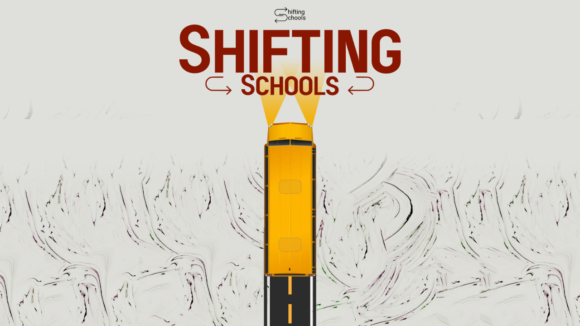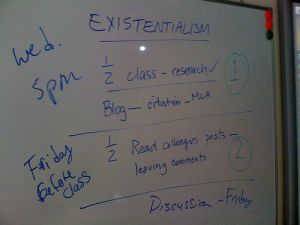
Reverse Instruction in IB SL English

reverse instruction
Today was our first day back to school after the holiday break and the first day of my little reverse instruction experiment with teachers and students. Jim Fitzgerald, who I’ve blogged about before, decided he’s be one of my guinea pigs….again.
What is Existentialism?
Every good student-led lesson starts with a guiding or essential question and here is ours. It’s a simple task really for these 11th graders. Research existentialism and write a blog post about what you believe it is linking to 3 or more resources in the process.
So here’s how we set up the lesson.
Day 1: Introduce the question and the plan
Plan:
Half the class (9 students) will research the question and write a blog post based on the research they found and what they believe existentialism to be. Their blog posts will be posted by Wednesday at 5pm.
The other half of the class (9 students) starting Wednesday at 5pm have until class starts on Friday to read the 9 blog posts, leave thoughtful comments, take notes, and prepare for a fishbowl activity Friday in class where they will talk about what they’ve learned and what they believe existentialism to be based on the research of their classmates.
Day 5: Friday’s Fishbowl:
Friday in class the commenters will be in the fishbowl along with Mr. Fitzgerald discussing what they believe existentialism to be quoting their classmates and the research they linked to in their blog posts.
The researchers will sit in a circle around the comments not allowed to talk to them (much like watching fish) but will be engaged in a chat-room (within Moodle) with each other discussing what is being talked about by the commenters in the middle. I will monitor the chat-room.
At the end of class…we bring everyone together to debrief about their experience.
The following week we give another question and we switch roles. The commenters become the reports and the reporters become the commenters. I’m really interested to see if the blog posts, comments, and discussion improve the second time through this lesson.
How we use class time:
Monday:
After explaining how this lesson will work, I took about 30 minutes to talk to the researchers (which is all of them in the long run) about how they find quality information on a topic they know nothing about. We talked about how Google works, how you can narrow down your search and how to use different syntax likes site:edu (which they thought was very cool). We talked about verifying the information once you found it by cross referencing with other sites, looking for an author and a date on the website as well. We talked about using Wikipedia, the links in the notes and the discussion tab as a starting place to narrow down the search to good, already authenticated, resources.
The kids didn’t touch a computer
Wednesday:
Will be used to answer any questions the kids might have at this point and then Mr. Fitzgerald will launch into talking about The Stranger, the book they are reading at the moment, and have a class discussion about the book (which they have finished outside of class time).
Friday:
The Fishbowl activity described above.
Closing the Circle:
So that’s the plan.
What I love most about this is I talk a lot with teachers about “closing the circle of learning” when it comes to students producing information on their blogs. That at our school, we have students write things on their blog, but we hardly ever use that information they produce back in the classroom. This activity brings the blog post, the research, back into the class to spark a discussion. So the circle is:
Students Research —–> Students writes blog post —–> Blog post becomes classroom discussion —–> Leads to more research/questions
Teacher’s Role:
What is the teacher’s role in all this? Could Mr. Fitzgerald just give a lecture and have a discussion about existentialism? Absolutely! But having the students come to their own conclusions about existentialism before having the discussion guided by the teacher we hope is more powerful.
The teacher’s role is also to teach the skills the students will need to complete the task. Today that is what I did. I taught the skills the kids would need to complete the task at hand. We talked about search, validity, and authenticating sites. We talked about what a good comment would look like, how you give feedback on an open web, and some strategies to use. We used class time to teach skills…their homework is about the content.
The teacher’s role (Mr. Fitzgerald) will also be to guide the discussion on Friday to ask questions and help students to find their own understanding of what existentialism is/means.
So…there you have it…..I’ll write more on Friday and if I have student permission I’ll include some of their comments and maybe a piece of the chat. Meanwhile if you want to read the blog posts the kids produce you can find them here when posted. The word “Existentialism” will be in the title.
More on Friday!








[…] plan followed much the same process as the one I blogged about using with the IB English class. However instead of using the blogs to post their research the students in this class will be using […]
Excellent planning! I think its very important that after writing blog posts it becomes classroom discussion which automatically will lead to more questions. Once My 3rd graders made Glogs and My 2nd graders and 4th graders commented and what came as a surprise that some of 2nd graders comments were simply amazing than 4th graders. So I would say its a perfect plan. I very well remember Alan November saying, “Unteach before you teach”.
[…] I’ve been working with teachers on.You can read the first blog posts here on the outline in English and U.S. […]
[…] discussed some options and settling on following a similar set-up that I used in a English classroom last […]
[…] from who. Have students read each others blog posts in preparation for a fishbowl discussion (link with a great description of what this looks like in a DP English Class). This can also mean […]
[…] from who. Have students read each others blog posts in preparation for a fishbowl discussion (link with a great description of what this looks like in a DP English Class). This can also mean […]